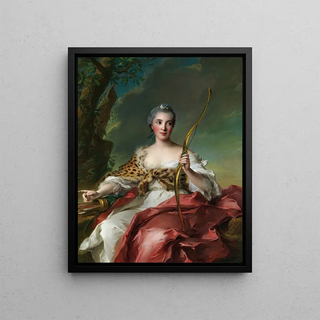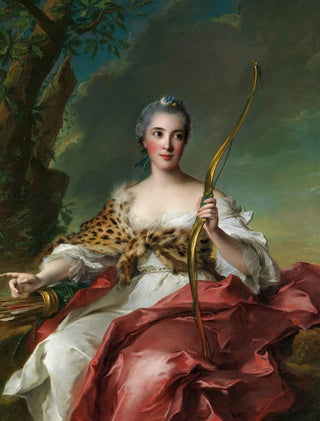Art print | Madame Bergeret de Frouville as Diana - Jean-Marc Nattier


View from behind

Frame (optional)
In the enchanting world of 18th-century painting, "Madame Bergeret de Frouville as Diana" emerges as an iconic artwork, the result of Jean-Marc Nattier's talent. This portrait, which embodies both beauty and grace, invites the viewer to immerse themselves in a realm where mythology and reality intertwine. Nattier, a master of the art print, succeeds in capturing not only the appearance of his subject but also the essence of an era marked by refinement and elegance. The depiction of Madame Bergeret, in the role of the goddess Diana, evokes subtle sensuality while asserting a calm strength, characteristic of court portraits of her time. Through this piece, the viewer is transported into the intimacy of a frozen moment, where feminine beauty is celebrated with unmatched delicacy.
Style and uniqueness of the artwork
Nattier's style is distinguished by fine detail and a delicate color palette that confer exceptional luminosity to his works. In "Madame Bergeret de Frouville as Diana," the way he renders the textures of the clothing, skin, and hair demonstrates unparalleled technical mastery. The drapery of the dress, a radiant white highlighted with golden touches, evokes celestial light, while the dark background accentuates the presence of the central figure. Every element is carefully considered to create visual harmony, where nuances intertwine to bring the composition to life. The model's posture, both relaxed and majestic, emphasizes the duality of her role: both goddess huntress and court lady. This artwork thus stands out for its ability to transcend the simple portrait, offering a reflection on femininity, power, and beauty.
The artist and his influence
Jean-Marc Nattier, born in 1685, is one of the most influential portraitists of his time, often associated with the Rococo style. Trained at the Royal Academy of Painting and Sculpture, he established himself through his talent for capturing the personality of his subjects, whether they come from nobility

Matte finish

View from behind

Frame (optional)
In the enchanting world of 18th-century painting, "Madame Bergeret de Frouville as Diana" emerges as an iconic artwork, the result of Jean-Marc Nattier's talent. This portrait, which embodies both beauty and grace, invites the viewer to immerse themselves in a realm where mythology and reality intertwine. Nattier, a master of the art print, succeeds in capturing not only the appearance of his subject but also the essence of an era marked by refinement and elegance. The depiction of Madame Bergeret, in the role of the goddess Diana, evokes subtle sensuality while asserting a calm strength, characteristic of court portraits of her time. Through this piece, the viewer is transported into the intimacy of a frozen moment, where feminine beauty is celebrated with unmatched delicacy.
Style and uniqueness of the artwork
Nattier's style is distinguished by fine detail and a delicate color palette that confer exceptional luminosity to his works. In "Madame Bergeret de Frouville as Diana," the way he renders the textures of the clothing, skin, and hair demonstrates unparalleled technical mastery. The drapery of the dress, a radiant white highlighted with golden touches, evokes celestial light, while the dark background accentuates the presence of the central figure. Every element is carefully considered to create visual harmony, where nuances intertwine to bring the composition to life. The model's posture, both relaxed and majestic, emphasizes the duality of her role: both goddess huntress and court lady. This artwork thus stands out for its ability to transcend the simple portrait, offering a reflection on femininity, power, and beauty.
The artist and his influence
Jean-Marc Nattier, born in 1685, is one of the most influential portraitists of his time, often associated with the Rococo style. Trained at the Royal Academy of Painting and Sculpture, he established himself through his talent for capturing the personality of his subjects, whether they come from nobility






